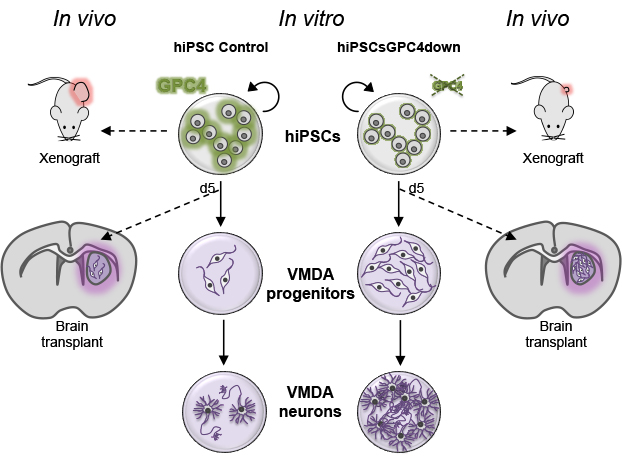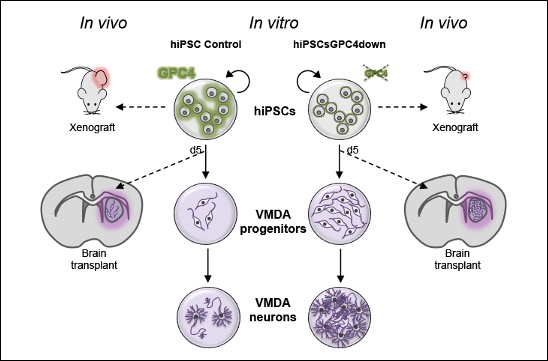The teams of F Maina and L Kerkerian-Le Goff publish in Stem Cells Translational Medicine a work led by Rosanna Dono showing that levels of the signal modulator GLYPICAN-4 are critical for the generation of midbrain dopamine neurons from human induced pluripotent stem cells and for overcoming their tumorigenic properties.
The possibility to generate disease-relevant cell types from human induced pluripotent stem cells (hiPSCs) offers unprecedented opportunities for medical research and clinical transplantation. In the context of Parkinson’s disease (PD), hiPSC-derived ventral midbrain dopaminergic (VMDA) neurons are considered crucial for disease modelling, drug discovery and cell replacement therapy, for which clinical trials have already begun in PD patients. To boost the clinical use of iPSC-derived VMDA neurons, intense research efforts aim at improving their quality and specification to develop cell preparations fulfilling safety criteria for clinical applications.
In this publication, we show that downregulation of GPC4 in hiPSCs promotes their differentiation into the ventral midbrain dopamine neuron (VMDA) lineage, both in vitro and after transplantation in rat brains. In depth studies in cell culture further show that GPC4 silencing in hiPSCs fosters the overall process of VMDA neuron generation, from progenitor stage to terminal neuronal maturation. In addition, hiPSCs with reduced GPC4 levels display impaired in vivo tumorigenesis, as shown by flank xenografts in mice. The GPC4 targeting approach has therefore the potential to boost the hiPSC application for disease modelling and cell replacement therapy for PD, by providing both more efficient generation of VMDA neurons and greater safety through dampening tumour side risks They also point to temporal modulation of GPC4 as a potential developmental mechanism contributing to the generation of human VMDA neurons.

To know more:
Enhanced differentiation of human induced pluripotent stem cells toward the midbrain dopaminergic neuron lineage through GLYPICAN-4 downregulation
Serena Corti, Remi Bonjean, Thomas Legier, Diane Rattier, Christophe Melon, Pascal Salin, Erik A. Toso, Michael Kyba, Lydia Kerkerian-Le Goff, Flavio Maina and Rosanna Dono.
Stem Cells Translational Medicine: 2021, February 2. https://doi.org/10.1002/sctm.20-0177
Contact
Rosanna Dono – rosanna.dono@univ-amu.fr




